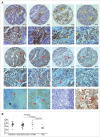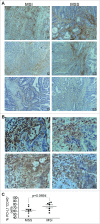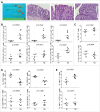The expression profiles and regulation of PD-L1 in tumor-induced myeloid-derived suppressor cells
- PMID: 28123883
- PMCID: PMC5214087
- DOI: 10.1080/2162402X.2016.1247135
The expression profiles and regulation of PD-L1 in tumor-induced myeloid-derived suppressor cells
Abstract
Programmed death-ligand 1 (PD-L1) is an inhibitory ligand that binds to PD-1 to suppress T cell activation. PD-L1 is constitutively expressed and inducible in tumor cells, but the expression profiles and regulatory mechanism of PD-L1 in myeloid-derived suppressor cells (MDSCs) are largely unknown. We report that PD-L1 is abundantly expressed in tumor-infiltrating leukocytes in human patients with both microsatellite instable and microsatellite stable colon cancer. About 60% CD11b+CD33+HLA-DR- MDSCs from peripheral blood of human colon cancer patients are PD-L1+. PD-L1+ MDSCs are also significantly higher in tumor-bearing mice than in tumor-free mice. Interestingly, the highest PD-L1+ MDSCs were observed in the tumor microenvironment in which 56-71% tumor-infiltrating MDSCs are PD-L1+in vivo. In contrast, PD-L1+ MDSCs are significantly less in secondary lymphoid organs and peripheral blood as compared to the tumor tissues, whereas bone marrow MDSCs are essentially PD-L1- in tumor-bearing mice. IFNγ is highly expressed in cells of the tumor tissues and IFNγ neutralization significantly decreased PD-L1+ MDSCs in the tumor microenvironment in vivo. However, IFNγ-activated pSTAT1 does not bind to the cd274 promoter in MDSCs. Instead, pSTAT1 activates expression of IRF1, IRF5, IRF7 and IRF8 in MDSCs, and only pSTAT1-activated IRF1 binds to a unique IRF-binding sequence element in vitro and chromatin in vivo in the cd274 promoter to activate PD-L1 transcription. Our data determine that PD-L1 is highly expressed in tumor-infiltrating MDSCs and in a lesser degree in lymphoid organs, and the pSTAT1-IRF1 axis regulates PD-L1 expression in MDSCs.
Keywords: IFNγ; MDSCs; MSI colon cancer; MSS colon cancer; PD-L1; T cells.
Figures







References
-
- Sun L, St Leger AJ, Yu CR, He C, Mahdi RM, Chan CC, Wang H, Morse HC 3rd, Egwuagu CE. Interferon Regulator Factor 8 (IRF8) Limits Ocular Pathology during HSV-1 Infection by Restraining the Activation and Expansion of CD8+ T Cells. PLoS One 2016; 11:e0155420; PMID:27171004; http://dx.doi.org/10.1371/journal.pone.0155420 - DOI - PMC - PubMed
-
- Simon S, Vignard V, Florenceau L, Dreno B, Khammari A, Lang F, Labarriere N. PD-1 expression conditions T cell avidity within an antigen-specific repertoire. Oncoimmunology 2016; 5:e1104448; PMID:26942093; http://dx.doi.org/10.1080/2162402X.2015.1104448 - DOI - PMC - PubMed
-
- Lim TS, Chew V, Sieow JL, Goh S, Yeong JP, Soon AL, Ricciardi-Castagnoli P. PD-1 expression on dendritic cells suppresses CD8 T cell function and antitumor immunity. Oncoimmunology 2016; 5:e1085146; PMID:27141339; http://dx.doi.org/10.1080/2162402X.2015.1085146 - DOI - PMC - PubMed
-
- Rosenbaum MW, Bledsoe JR, Morales-Oyarvide V, Huynh TG, Mino-Kenudson M. PD-L1 expression in colorectal cancer is associated with microsatellite instability, BRAF mutation, medullary morphology and cytotoxic tumor-infiltrating lymphocytes. Mod Pathol 2016; 29:1104-12; PMID:27198569; http://dx.doi.org/10.1038/modpathol - DOI - PubMed
-
- Dunne PD, McArt DG, O'Reilly PG, Coleman HG, Allen WL, Loughrey M, Van Schaeybroeck S, McDade S, Salto-Tellez M, Longley DB et al.. Immune-derived PD-L1 gene expression defines a subgroup of stage II/III colorectal cancer patients with favorable prognosis that may be harmed by adjuvant chemotherapy. Cancer Immunol Res 2016; 4:582-91; PMID:27197062; http://dx.doi.org/10.1158/2326-6066.CIR-15-0302 - DOI - PubMed
Publication types
Grants and funding
LinkOut - more resources
Full Text Sources
Other Literature Sources
Molecular Biology Databases
Research Materials
